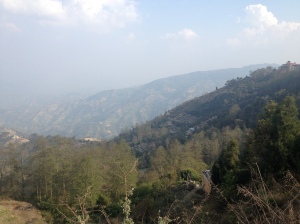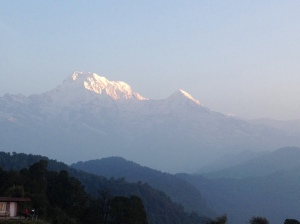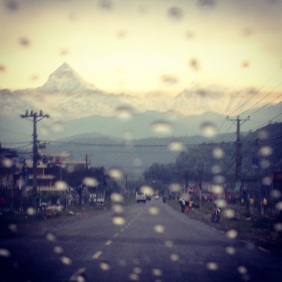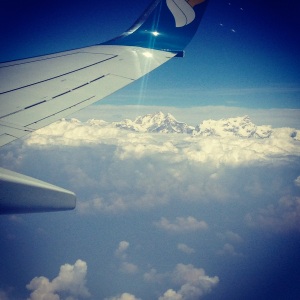Tadasana (mountain pose): Stand tall with the feet together or slightly apart, all four corners of them pressing into the earth, drawing up through the inner arches. Firm the thighs and lift the knee caps. Imagine a thread of light travelling all the way up the spine and out through the crown of the head. Lengthen the tailbone towards the floor. Draw the shoulder blades down and back. Lift the top of the sternum and widen the collarbones. Let the arms hang alongside the body. Have the chin parallel with the floor and soften the eyes. Press the palms of the hands together at the heart. Namaste.
Of the fourteen mountains in the world that are taller than 8,000 metres, eight of them are in Nepal.
For my first weekend there, my friends took me to Nagarkot in the Kathmandu Valley – famous for its Everest views. Sitting out on the terrace that connected our Tibetan-themed rooms, I cooed over the setting sun flaming over distant and smoky-coloured hills. But my friends just shook their heads. The haze was obscuring the mountains; this, I was assured, was nothing.
I caught my first glimpse of a Himalayan peak on the initial night of my Annapurna circuit trek with Pokhara-based Purna Yoga. I was tramping across the muddy central courtyard of Australian Camp, hoping against hope that my soggy trekking clothes had dried, when I was held up by a group of Americans and Canadians, chins aloft. I followed the line of their gaze but all I could see were clouds sitting prettily atop the hills.
‘See – one peak,’ came our guide and yoga instructor Mahesh’s voice from behind me.
I looked again. A pinkish white cloud seemed to hover above the dark mass of the hills. I blinked. No, not a cloud.
‘A peak,’ Mahesh confirmed, smiling at my expression.
Following that, every morning of the trek, we were awoken by Mahesh or our heroic porter Dinesh, bearing sweet, milky Nepali tea and swirling the playing stick gently around a singing bowl (my iPhone alarm will never be the same again) at around 6 a.m., in time for us to watch the rising sun shining pinkly on the side of Annapurna South, Machapuchare or – on the last morning, after
we’d trekked up Panchassee Hill – Dhaulagiri.
When my flight back from Pokhara to Kathmandu was cancelled, I ended up travelling back to the capital in a private car. We had stopped in a small town outside the lakeside tourist city for the driver to fuel up and, settling in for a long journey, I was engrossed in my book. Suddenly, something in my peripheral vision caught my attention. Looking up, I realised that the windows on the left side of the car were entirely filled – bigger and closer and more awe-inspiring than I could have ever imagined – by a Himalayan massif. It was as startling and as alien-looking as a spacecraft. I found myself yabbering incoherently – much to the consternation of my driver – tears in my eyes.
This is my yoga journey through Nepal. . .
Adho mukha svanasana (downward-facing dog pose): From uttanasana (forward fold), step both feet to the back of the mat. Have them together or parallel. Plant the palms into the mat, drawing energy up through the arms. Melt the shoulder blades into the back and have the ears between the biceps, the neck in line with the rest of the spine. Draw the tailbone long and stretch through the hamstrings, working the heels towards the floor.

Nepali soldiers, the Gurkhas are famed for their fearlessness and military prowess. Many have been involved in the post-earthquake rescue operation
Virabhadransana 1 (warrior 1 pose): Step your left foot towards the back of the mat, six to eight feet from the front foot. Have the right foot facing forwards, the left angled slightly inwards, the arch of the left in line with the heel of the right. Plant the outside edge of the back foot firmly into the mat and draw up through the legs. Inhale and, on the exhalation, bend the front knee, working towards getting the front thigh parallel with the floor. Ensure the front knee is no further forwards than the ankle. Root strongly down through the legs and then lift the arms upwards, clasping the hands. Turn the face towards the hands. Repeat on the other side.

The pipal or bodhi (old fig) tree is famed as being the type under which Siddhartha Gautama – the original Buddha – achieved enlightenment. They are often meeting or resting points for local communities in Nepal
Vrksasana (tree pose): Stand up straight, feet together. Fix the gaze on a point on the floor ahead. Rooting down through the left foot, slowly take the weight off the right, drawing it up the left leg to rest on the left ankle, shin or thigh. If balance allows, lift the hands above the head.

Half man, half bird, Garuda is the vehicle and devotee of Vishnu. This is his statue in the UNESCO World Heritage Site Durbar Square in Patan. The square suffered major damage in the quakes
Garudasana (eagle pose): Start in tadasana. Bend the knees slightly, lift the left foot up and, balancing on right foot, cross the left thigh over the right. Hook the top of the foot behind the lower right calf and balance on the right foot. Stretch the arms straight forward, parallel to the floor. Cross them in front of torso so that the right arm is above the left, then bend elbows. Hook the right elbow into the crook of the left, and raise the forearms perpendicular to the floor, the backs of the hands facing each other. Press the right hand to the right and the left hand to the left, so that the palms are now facing each other. The thumb of the right hand should pass in front of the little finger of the left. Now press the palms together, lift the elbows, and stretch the fingers toward the ceiling. Repeat the pose with the arms and legs reversed.

Machhapuchchhre – or the Fish Tail – in the Annapurna range. This peak is believed to be sacred to Shiva and is therefore out of bounds for climbers
Ardha matsyendrasana (half lord of the fishes pose): Sit with legs straight out in front. Bend knees, put feet on the floor, then slide left foot under the right leg to the outside of the right hip. Lie the outside of the left leg on the floor. Step the right foot over the left leg and stand it on the floor outside the left hip. The right knee will point directly up at the ceiling. Exhale and twist towards the inside of the right thigh. Press the right hand against the floor just behind the right buttock, and set the left upper arm on the outside of the right thigh near the knee. Pull the front torso and inner right thigh snugly together. Press the inner right foot into the floor and lengthen the front torso. Lengthen the tailbone into the floor. Turn the head to the right. With every inhalation, lift a little more through the sternum, pushing the fingers against the floor. Twist a little more with every exhalation. Return to the starting position and repeat to the left.

As we trekked, hundreds of butterflies cascaded down the hillsides all around us; beautiful to look at though a pest for the local farmers
Bahdha konasana (cobbler’s pose): Sit upright and bring the feet together. Holding onto the feet, bring the hips towards them. Open the feet outwards like the pages of a book so that the outside edges touch but the soles face upwards. Draw up through the spine and inhale. On the exhalation, use the muscles of the thighs and buttocks to squeeze the knees closer to the floor like butterfly wings. Repeat.

The cow is the national animal of Nepal. As in other Hindu-majority countries, the slaughter of cows and bulls in Nepal is completely banned
Gomukhasana (cow face pose): Sit upright with the legs straight out in front, then bend the knees and put the feet on the floor. Slide the left foot under the right knee to the outside of the right hip. Then cross the right leg over the left, stacking the right knee on top of the left, and bring the right foot to the outside of the left hip. Try to bring the heels equidistant from the hips. Sit evenly on the sitting bones. Inhale and stretch the right arm straight out to the right, parallel to the floor. Rotate the arm inwardly; the thumb will turn first towards the floor, then point behind, the palm facing the ceiling. Exhaling, sweep the arm behind the torso and tuck the forearm into the hollow of the lower back, working the forearm up the back until it is parallel with the spine. The back of the hand should be working towards being between the shoulder blades. Inhale and stretch the left arm straight forward, pointing toward the opposite wall, parallel to the floor. Turn the palm up and, with another inhalation, stretch the arm straight up towards the ceiling, palm turned back. Bend the elbow and reach down for the right hand. If possible, hook the right and left fingers. Lift the left elbow towards the ceiling and, from the back armpit, descend the right elbow toward the floor. Repeat with the opposite arm and leg configuration.

Viparita karani in our tea house accommodation was a perfect post-trek way to stretch out the legs every day
Viparita karani (legs against the wall): Start sitting curled up sideways on the floor against a wall, with the bottom as close to the wall as possible. Roll over to bring the base of the spine flush against the wall and extend the legs upwards. Stay here and breathe.
Chakrasana (wheel pose – also known as urdhva dhanurasana: upward-facing bow): Lie down on the back with hands by the sides. Bend the knees and bring the heels as close to the buttocks as possible, keeping them wider than hip width apart. Raise the hands and bring them back next to the ears. Place the palms on the floor with the fingers pointing towards the shoulders. Lift the body up with the support of the palms and the feet. Rotate the head slightly, so that the gaze is towards the floor. Stretch the thighs and shoulders.
Balasana (child’s pose): Kneel on the floor, big toes touching, and bottom on heels. Separate the knees about as wide as the hips. Lay the torso between the thighs. Lengthen the tailbone away from the back of the pelvis while lifting the base of the skull away from the back of the neck. Lay the hands on the floor alongside the torso, palms up.
Savasana (corpse pose): Lie flat on the back on the floor, feet mat width apart, rolling gently outwards, arms away from the body, palms facing up. Allow the eyes to gently close and the breath to deepen. Bring the awareness to the breath. Listen to the breath. Listen to the heartbeat. Relax and let go.
After my surprise mountain-glimpses from the car on the way back to Kathmandu, when the time came for me to fly home, I was somewhat prepared. I had been unable to check-in online, and the queues at Kathmandu airport were monstrous, so I had to settle for whatever seat was remaining. But luckily the kind Nepali man travelling to the Gulf who was allocated the window seat in my row wanted to sit next to his friend so swapped with me. I sat with my face as close to the window as I could get it, and for the first half hour of the flight, watched peak after peak poking through the clouds, looking so near I imagined I could touch them.
As the world knows, on 25th April this year (less than four weeks after I got back from my trip), Nepal was hit by the biggest earthquake it has experienced in 83 years – measuring 7.8 on the magnitude scale. This was followed by multiple severe aftershocks, including one that registered at 7.3 on the 12th May. The initial earthquake has killed upwards of 8,000 people, and injured many more – according to latest figures. The 12th May quake triggered landslides and has injured around 2,300 people. I’m very lucky that my friends and the people I met and visited there are all safe. But I think of the tiny villages we passed through on the trek, the smiling villagers, the farmers in their fields, the children in their smart school uniforms calling ‘Namaste!’– all their lives now changed forever. As as the outpouring of international aid has appeared to recognise, even beyond the immediate tragedy, the toll of these last few devastating weeks will continue to be felt for years to come. It is hard to know what best to do to help, where the money can be put to most use. Below are a few suggestions.
Purna Yoga:
This is the company who organised my trek. Families of their staff have been badly hit by the quakes. They have set up a fund to support these families and their local communities, and details of this, as well as how they have been spending the money, can be found on their Facebook page.
https://www.facebook.com/nepalyogatrek
GIZ:
The organisation for which my Nepal-based friends work. They have set up a fund that will directly support the rebuilding of their Nepali staff members’ houses that were destroyed. The details are:
Account name: Deutsche Gesellschaft für Internationale Zusammenarbeit (GIZ) GmbH
Account number: 504 089 10
Bankleitzahl: 504 000 00
oder
IBAN: DE29 5040 0000 0050 4089 10
BIC: MARKDEFFXXX
Reference:
„Spende Erdbeben Nepal Nationale Mitarbeiter GIZ“
https://www.giz.de/en/html/about_giz.html
Himalayan Disaster Relief Volunteer Group
An impressive community initiative that has done much necessary work since the earthquake. Their coordination efforts have been so effective that some bigger relief agencies are now working through them also. Here is an article about the efforts: http://www.wired.com/2015/05/nepal-earthquake-aid/
You Caring:
The organisation coordinating this campaign are well thought of and have done impressive work so far.
DZI Foundation:
An NGO in Nepal that is doing good work in the aftermath of the earthquakes. It is run by an American who has lived in Nepal for 16 years. They have a lot of experience.
Next Generation Nepal:
http://www.nextgenerationnepal.org/Donate_Online
MSF:






